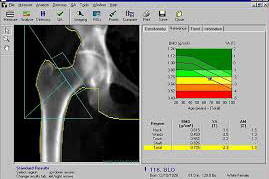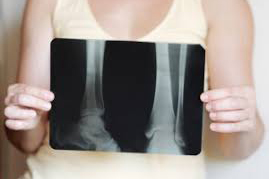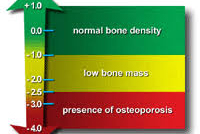A bone density test is the only test that can diagnose osteoporosis before a broken bone occurs. This test helps to estimate the density of your bones and your chance of breaking a bone. The National Osteoporosis Foundation recommends a bone density test of the hip and spine by a central DXA machine (dual energy Xray absorptiometry) to diagnose osteoporosis.
If you a postmenopausal woman or man age 50 and older and recently broken a bone, then you should talk to your doctor or other healthcare provider about getting a bone density test if you have never had one.
Although osteoporosis is more common in older women, men also can develop the condition. Regardless of your sex or age, your doctor may recommend a bone density test if you’ve:
- Lost height.People who have lost at least 1.5 inches (3.8 centimeters) in height may have compression fractures in their spines, for which osteoporosis is one of the main causes.
- Fractured a bone.Fragility fractures occur when a bone becomes so fragile that it breaks much more easily than expected. Fragility fractures can sometimes be caused by a strong cough or sneeze.
- Taken certain drugs.Long-term use of steroid medications, such as prednisone, interferes with the bone-rebuilding process — which can lead to osteoporosis.
- Had a drop in hormone levels.In addition to the natural drop in hormones that occurs after menopause, women’s oestrogen may also drop during certain cancer treatments. Some treatments for prostate cancer reduce testosterone levels in men. Lowered sex hormone levels weaken bone.


The test tells you if you have normal bone density, low bone density (osteopenia) or osteoporosis.
It is the only test that can diagnose osteoporosis. The lower your bone density, the greater your risk of breaking a bone.
A bone density test can help you and your healthcare provider:
- learn if you have weak bones or osteoporosis before you break a bone
- predict your chance of breaking a bone in the future
- see if your bone density is improving, getting worse or staying the same
- find out how well an osteoporosis medicine is working
- let you know if you have osteoporosis after you break a bone
The Bone density test itself-
Bone density tests are non-invasive and painless. This means that no needles or instruments are placed through the skin or body. The test usually takes less than 15 minutes. With most types of bone density tests, a person remains fully dressed making sure there are no zips in the way of the area to be scanned.
Standard x-rays cannot be used in place of bone density tests. Unlike bone density tests, X-rays are not able to show osteoporosis until the disease is well advanced. However, X-rays can be used in addition to a DXA to detect broken bones in the spine or elsewhere.
Understanding your results
Your bone density test results are reported using T-scores. A T-score shows how much your bone density is higher or lower than the bone density of a healthy 30-year old adult. A healthcare provider looks at the lowest T-score to diagnosis osteoporosis.
What Your T-score Means. According to the World Health Organization (WHO):
- A T-score of -1.0 or above is normal bone density. Examples are 0.9, 0 and -0.9.
- A T-score between -1.0 and -2.5 means you have low bone density or osteopenia. Examples are T-scores of -1.1, -1.6 and -2.4.
- A T-score of -2.5 or below is a diagnosis of osteoporosis. Examples are T-scores of -2.6, -3.3 and -3.9.
When do I need treatment?
Below are treatment guidelines for postmenopausal women and men age 50 or older:
Most people with T-scores of -1.0 and above (normal bone density) do not need to take an osteoporosis medicine.
Some people with T-scores between -1.0 and -2.5 (low bone density or osteopenia) should consider taking an osteoporosis medicine when they have certain risk factors.
All people with T-scores of -2.5 and below (osteoporosis) should consider taking an osteoporosis medicine.
Having low bone density or osteopenia does not mean you will get osteoporosis. It means you have a greater chance of developing osteoporosis if you lose bone in the future.
How often should I repeat the test?
If you are on osteoporosis medication your test should be repeated every 1-2 years
For further information about osteoporosis and osteopenia see further articles on this site

